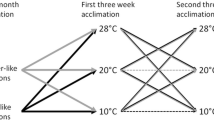Abstract
For their seasonal control of thermogenesis Djungarian hamsters rely on environmental cueing by both photoperiod and ambient temperature. Their total potential for adaptive improvements of nonshivering thermogenesis is constant in summer and winter. The shortening of photoperiod in fall is used to anticipate about half of the total improvement in thermogenesis, in advance of any experience of cold, as can be concluded from the photoperiodic control of thermogenesis, cold resistance, and the protein content, cyctochrome oxidase activity and content of mitochondria in brown adipose tissue. The remainder of the seasonal thermogenic adaptation is due to stimulatory responses to chronic exposure to cold.
Similar content being viewed by others
References
BRÜCK, K., WÜNNENBERG, W., and ZEISBERGER, E. (1969): Comparison of cold-adaptive metabolic modifications in different species, with special reference to the miniature pig. Fed. Proc. 28: 1035–1041.
HELDMAIER, G. (1975): The effect of short daily cold exposures on development of brown adipose tissue in mice. J. comp. Physiol. 90: 161–168.
HELDMAIER, G., and STEINLECHNER, S. (1981a): Seasonal pattern and energetics of short daily torpor in the Djungarian hamster,Phodopus sungorus. Oecologia 48: 265–270.
HELDMAIER, G., and STEINLECHNER, S. (1981b): Seasonal control of energy requirements for thermoregulation in the Djungarian hamster (Phodopus sungorus), living in natural photoperiod. J. comp. Physiol. 142: 429–437.
HELDMAIER, G., STEINLECHNER, S., RAFAEL, J., and VSIANSKY, P. (1981): Photoperiodic control and effects of melatonin on nonshivering thermogenesis and brown adipose tissue. Science 212: 917–919.
HELDMAIER, G., STEINLECHNER, S., and RAFAEL, J.(in press): Nonshivering thermogenesis and cold resistance during seasonal acclimatization in the Djungarian hamster. J. comp. Physiol.
JANSKY, L. (1973): Nonshivering thermogenesis and its thermoregulatory significance. Biol. Rev. 48: 85–132.
RAFAEL, J., and WRABETZ, E. (1976): Brown adipose tissue mitochondria: Recoupling caused by substrate level phosphorylation and extramitochondrial adenosine phosphates. Eur. J. Biochem. 61: 551–561.
SMITH, R. E., and HORWITZ, B. A. (1969): Brown fat and thermogenesis. Physiol. Rev. 49: 330–425.
STEINLECHNER, A., and HELDMAIER, G. (1982): Role of photoperiod and melatonin in Seasonal Acclimatization of the Djungarian hamster,Phodopus sungorus. Int. J. Biometeorol. 26: 329–337.
WUNDER, B. A. (1981): Effects of short-term, daily, cold exposure on brown adipose tissue and nonshivering thermogenesis in the house mouse and prairie vole. Acta Univ. Carolina-Biol. 1979: 315–318.
Author information
Authors and Affiliations
Additional information
This research was supported by the Deutsche Forschungsgemeinschaft, Schwerpunktprogramm “Mechanismen der Temperaturregulation und -Adaptation”.
Rights and permissions
About this article
Cite this article
Heldmaier, G., Steinlechner, S., Rafael, J. et al. Photoperiod and ambient temperature as environmental cues for seasonal thermogenic adaptation in the Djungarian hamster,Phodopus sungorus . Int J Biometeorol 26, 339–345 (1982). https://doi.org/10.1007/BF02219505
Received:
Issue Date:
DOI: https://doi.org/10.1007/BF02219505




